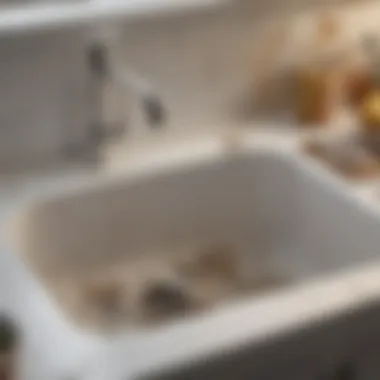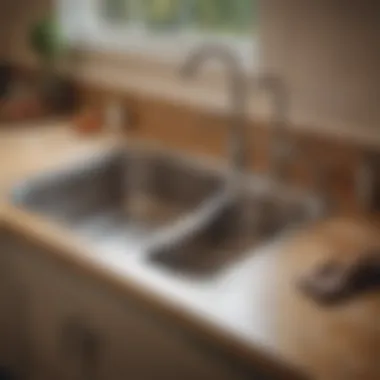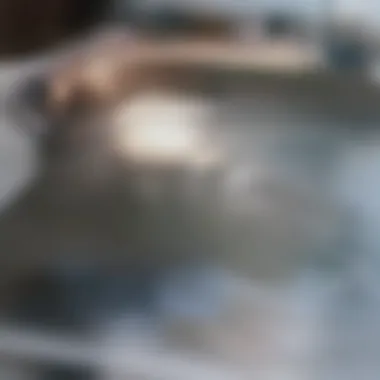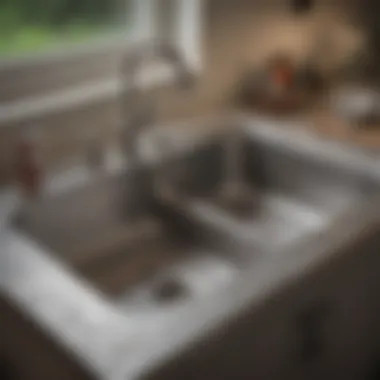Effective Solutions for a Slow Draining Kitchen Sink


Intro
A slow draining kitchen sink can be a significant inconvenience. Homeowners often find themselves frustrated as they attempt to wash dishes or prepare food, only to discover that the water isn't moving as it should. This article is designed as a comprehensive guide to understanding and remedying the slow drainage issue. We’ll explore the causes behind this common problem and provide practical solutions to improve sink functionality.
Identifying the sources of drain blockage is critical. Sometimes, the issue is minor and can be fixed with basic home tools. Other times, it may require professional intervention. Regardless, knowledge of the problem leads to effective actions that can preserve the integrity of your kitchen plumbing.
Additionally, few pertinent preventative measures can be employed to reduce the likelihood of experience these issues in the first place. With a proactive approach, homeowners can maintain their sinks, keeping kitchens functional and aesthetically pleasing.
Stay with us as we delve into the intricate details of diagnosing and addressing slow draining issues, ensuring your kitchen remains a harmonious space for both culinary ambition and design integrity.
Preface to Kitchen Sink Drainage Issues
In modern homes, the kitchen sink plays a crucial role in daily activities. Thus, addressing drainage issues becomes paramount. A slow draining kitchen sink is not just a nuisance; it can lead to more significant problems over time. Understanding the mechanisms that cause these issues is essential for anyone responsible for maintaining a home. This section will provide important insights into the fundamentals of kitchen sink drainage, the implications of inefficient systems, and the necessity of effective solutions.
Understanding the Basics of Kitchen Sinks
Kitchen sinks consist of several components that work in unison to facilitate water flow. The main parts include the sink basin, faucet, P-trap, and drainage pipes. Each element plays a vital role in ensuring that water drains correctly. The P-trap prevents odors from entering the home by creating a water seal, while the pipes transport waste away. Familiarizing oneself with these components is beneficial, as it aids in identifying potential problems.
When a kitchen sink is poorly designed or poorly maintained, drainage issues can arise. Clogs often develop due to a buildup of debris or grease. Ignoring these complications can aggravate the problem, resulting in severe plumbing issues. The importance of understanding these basics cannot be overstated, as it empowers homeowners to recognize early signs of trouble
Importance of Efficient Drainage
Efficient drainage in the kitchen sink has significant implications for both functionality and hygiene. A properly functioning drainage system is essential for maintaining a clean cooking environment. When water flows smoothly, it minimizes the risk of contamination from stagnant water pooling around food preparation areas.
Moreover, efficient drainage prevents unpleasant odors that may occur when waste is trapped in the pipes. On a practical level, resolving slow drainage can also save time, reducing the need for frustrating fixes down the line.
In sum, prioritizing kitchen sink drainage issues is crucial for homeowners. Knowledge of the underlying causes leads to quicker resolutions and long-term satisfaction with their plumbing systems. By understanding the basics of kitchen sinks and recognizing the importance of efficient drainage, individuals are better equipped to maintain their living spaces effectively.
"An ounce of prevention is worth a pound of cure."
Taking proactive steps can prevent costly repairs and ensure a functional kitchen.
Common Causes of Slow Draining Sinks
Understanding the common causes behind slow draining sinks is crucial for effective resolution. Identifying these issues early can save homeowners from more significant problems down the line. Often, slow drainage is not just a minor inconvenience; it can lead to further complications, such as water damage or plumbing failures. By recognizing the specific causes, one can take proactive measures to maintain a functional drainage system in the kitchen.
Clogs from Food Particles and Debris
One of the primary reasons for a slow draining kitchen sink is the accumulation of food particles and debris. Over time, when food scraps are rinsed down the sink, they can combine and create a blockage. This is particularly common in households that often use their kitchen sink for washing dishes.
It's essential to be mindful of what goes down the drain. Even seemingly harmless items, like small bits of vegetable peels, can contribute to clogs. Regularly using a strainer can help prevent these particles from entering the sink. This simple solution can significantly reduce clogs and ensure smoother drainage.
Grease Buildup: A Persistent Problem
Another common culprit is grease buildup. When cooking, fats and oils often find their way into the sink. As the grease cools, it hardens and adheres to the sides of the pipes. This accumulation narrows the passage through which water flows. Eventually, this leads to slow draining and can necessitate more intense cleaning methods.
To combat grease buildup, it's advisable to avoid pouring oils or fats down the sink. Instead, collect them in a container and throw them in the trash. Regular hot water flushing may help keep the pipes cleaner, but prevention is the most effective strategy.


Issues with the P-Trap
The P-trap is a crucial component of the kitchen sink plumbing system. Its function is to hold water, which prevents sewer gases from entering the home. However, it can also trap debris and build up, leading to slow drainage. If the P-trap becomes blocked, it may require disassembly and cleaning.
Inspecting the P-trap regularly can enhance overall drainage. While doing this, ensure that there are no leaks; if leaks are present, they should be addressed immediately to avoid water damage.
Ventilation Problems in Plumbing
Proper ventilation is vital for the plumbing system's functionality. If there is an issue with ventilation, it can cause drainage problems. Vents allow air to enter the plumbing system, enabling water to flow freely. If these vents are blocked, it creates a vacuum effect that hinders proper drainage.
Identifying ventilation issues often requires looking at the entire plumbing system. If slow drainage is persistent despite cleaning and clearing clogs, it might be worth consulting a professional plumber. They can assess whether the venting system is functioning properly.
Identifying and addressing the common causes of slow draining sinks can save considerable effort and expense in the future.
Diagnosing Drainage Problems
Diagnosing drainage problems is a critical step in addressing the issues connected to a slow draining kitchen sink. This process involves carefully evaluating the symptoms and identifying the root causes of the problem. Understanding these drainage issues is essential. It often leads to more effective and cost-efficient solutions. Ignoring the signs can result in further complications and potentially more extensive damage to your plumbing system.
One major consideration is that early diagnosis can prevent minor issues from escalating. For example, a simple clog could lead to more severe blockages or even leaks, which could require professional intervention. Additionally, reliance on vague or improper diagnosis methods may lead homeowners to employ ineffective solutions that waste time and money. By employing systematic diagnostics, one can ensure the right approach is taken.
Most importantly, monitoring the drainage process can point towards the specific underlying issue, allowing for targeted interventions. When the correct problem is diagnosed, it not only saves on immediate repairs but also enhances the performance and longevity of the plumbing system.
Visual Inspection Techniques
Visual inspection is often the first step in diagnosing drainage problems. This method allows homeowners to detect visible signs of trouble. Begin by checking the kitchen sink and surrounding areas. Look for water stains, leaks, or other signs of moisture.
- Observe the sink's drainage performance. If water pools or drains slowly, make a note of how long it takes to clear.
- Check under the sink for any visible leaks in the pipes or connections.
- Inspect the P-trap and other plumbing components. Ensure they are correctly installed and free from damage.
- Look at the disposal unit, if available, to see if it’s functioning properly.
This method is straightforward and requires no special tools. However, it may not always reveal hidden issues, which makes further testing necessary.
Testing Water Flow
Testing water flow is another effective technique in diagnosing kitchen sink drainage problems. This involves running water through the sink and observing how it behaves under normal conditions.
- Turn on the faucet to a steady stream and note if the water drains without obstruction.
- If water stagnates or drains at varying speeds, this signals potential issues.
- You can also fill up the sink to measure how long it takes to drain completely. A significant delay indicates a problem.
Testing flow helps to determine the severity of the issue and whether it comes from the sink itself or further down the plumbing system.
Utilizing Drain Cleaners
Utilizing drain cleaners can assist in diagnosing drainage problems as well. It's important to remember that not all cleaners are suitable for every situation.
- Chemical Drain Cleaners: These are effective for dissolving minor clogs caused by grease or food particles. Follow the instructions carefully to avoid damage.
- Enzymatic Cleaners: These target organic matter in the pipes and may work more slowly but can be safer for your plumbing.
Before using any cleaner, consult the product labels to confirm compatibility with your pipes. Evaluate the sink's response after application; if there is no improvement, further investigation may be required.
Utilizing these various methods will provide a comprehensive assessment of the drainage situation in your kitchen sink, allowing for quicker and more efficient resolutions.


Step-by-Step Solutions for Fixing Slow Drains
When facing a slow draining kitchen sink, employing a structured approach to resolve the issue is essential. This section serves as a detailed guide to systematically address the problem through practical solutions. Understanding these methods allows homeowners and design enthusiasts to take action confidently. Each solution outlined below offers a hands-on approach, ensuring effective interventions to restore proper drainage functionality without extensive plumbing expertise.
Disassembling the P-Trap
The P-trap is a crucial component in the kitchen drainage system. It is located beneath the sink and serves multiple important functions, such as preventing sewer gases from entering the home. Properly disassembling the P-trap is the first step in clearing out potential blockages.
- Gather Tools: Before starting, ensure you have a bucket, adjustable wrench, and possibly a pair of gloves. These will help manage water spills and protect your hands.
- Place a Bucket: Position the bucket under the P-trap. This will catch any water that may spill when you disassemble the trap.
- Loosen the Fasteners: Using the adjustable wrench, carefully loosen the slip nuts connecting the trap to the sink drain and the wall pipe. Take care not to damage the plumbing.
- Remove the Trap: Once the nuts are loose, gently pull the P-trap away from the fixtures. Inspect the trap for any debris or buildup that may be causing the slow drainage.
- Clean the Trap: Rinse it thoroughly with hot water. If there are stubborn clogs, use a brush to scrub it clean.
Taking these steps helps remove blockages, allowing for better flow of water down the drain.
Clearing Clogs with a Plumber's Snake
A plumber's snake is a powerful tool designed to reach deep blockages that standard cleaning cannot resolve. This method requires some preparation but can effectively clear stubborn clogs.
- Insert the Snake: Begin by feeding the snake into the drain until you feel resistance. This indicates a blockage.
- Rotate the Snake: Rotate the handle clockwise. This action helps catch on the clog, allowing you to pull it towards you.
- Extract the Clog: Once you feel that you've secured the clog, gently pull the snake back out of the drain. Some debris will likely come with it.
- Check Drainage: After removing the clog, run hot water through the drain for a few minutes. This ensures that any residual material is cleared away.
Regular use of a plumber’s snake can significantly reduce the risk of recurring drain problems.
Using Baking Soda and Vinegar
A natural and effective method for dealing with slow drains involves using baking soda and vinegar. This combination creates a chemical reaction that can break down minor clogs without harsh chemicals.
- Pour Baking Soda: Start by pouring about half a cup of baking soda directly down the drain.
- Follow with Vinegar: Pour an equal amount of vinegar into the drain. The mixture will fizz and bubble, which helps to dislodge light clogs.
- Wait: Allow the solution to sit for about 30 minutes, giving it time to work on the blockage.
- Rinse with Hot Water: Finally, flush the drain with hot water to clear out any remaining debris.
This method is especially useful for minor clogs caused by grease and food particles.
Maintenance of Drainage System
Long-term efficiency of your kitchen sink relies on consistent maintenance practices. This approach prevents future issues and keeps the drainage system functioning optimally.
- Routine Cleaning: Regularly use baking soda and vinegar every few months as a preventive measure.
- Install Drain Covers: Using drain covers can greatly reduce the introduction of food particles and debris into the drain.
- Monitor Disposal Habits: Be mindful of what goes down the disposal; avoid fibrous or starchy items that can create clogs.
- Check Pipes Regularly: Inspect visible plumbing for signs of wear or buildup. Early detection can save costly repairs later.
- Schedule Professional Inspections: Consider professional evaluations of your plumbing system every few years for a comprehensive check.
By prioritizing these maintenance strategies, homeowners can extend the lifespan of their kitchen drainage systems and prevent problems before they arise.
Preventative Measures for Future Issues
Effective prevention can save homeowners time and money in managing kitchen drainage issues. This section illustrates essential practices that ensure drains operate smoothly over time. Investing in preventative measures not only preserves the functionality of kitchen sinks but also enhances longevity of plumbing systems.
Regular Maintenance Tips
Establishing a routine maintenance schedule is crucial. Regular inspections can identify potential issues before they escalate. Simple actions, such as checking for minor leaks and ensuring there are no signs of mold growth around the sink, can be beneficial.
- Check the sink and surrounding areas for any leaks that could signify a blockage.
- Run hot water through the sink regularly to dissolve grease buildup.
- Periodically use a mixture of vinegar and baking soda to clean the drain. This natural remedy can help break down minor clogs and reduce odors.
By maintaining these practices, homeowners can address small problems that may lead to larger issues in the future.


Best Practices for Dish Disposal
Proper disposal of food remnants is vital in preventing slow draining sinks. Many homeowners may find it convenient to rinse dishes and wash down food particles, but this could lead to significant drainage problems later on.
- Always scrape plates before washing them. This reduces the amount of food particles entering the sink.
- Avoid pouring grease down the drain. Instead, collect it in a separate container.
- Consider investing in a composting system for larger food scraps. This can minimize what goes into the sink and decrease the chances of clogs.
Making these changes can significantly mitigate the risks of developing drainage problems stemming from kitchen waste.
Effective Use of Drain Covers
Drain covers serve as an excellent line of defense against unwanted debris. Utilizing these covers will help capture food particles and prevent them from slipping into the plumbing system.
- Choose a drain cover with a fine mesh. This type is effective in filtering out small food particles.
- Regularly clean the drain covers to ensure they function correctly. Accumulated debris can block the cover, which can create pressure and lead to drainage issues.
- Consider using weighted drain covers that can stay in place better during washing, preventing items from entering the drain inadvertently.
Adopting these practices will not only assist in any kitchen sink maintenance but also contribute to an overall healthier plumbing system.
Considerations for Major Repairs
When dealing with a slow draining kitchen sink, it's crucial to understand when to consider more intensive repairs. Some issues can be resolved with basic maintenance, but others may require professional intervention. Recognizing the signs that indicate a more serious plumbing problem can significantly reduce further damage and costs.
Major repairs often involve extensive plumbing work, replacement parts, or even complete system overhauls. The often hidden nature of plumbing systems means that what appears to be a simple drain issue can, in fact, be symptomatic of larger underlying problems. Poor drainage can result in water damage, mold growth, and more serious health hazards if not addressed promptly. Thus, knowing when to call a professional is paramount for safeguarding both the kitchen and the household's well-being.
When to Call a Professional
Homeowners may face uncertainty in deciding whether a problem requires professional plumbing assistance. Here are some indicators that suggest the need for expert help:
- Recurring Issues: If slow drainage is a persistent problem despite attempts to fix it, a professional can identify deeper plumbing concerns.
- Complex Clogs: When using a drain snake or standard cleaners does not resolve the issue, it may be time for a professional to assess the pipes and drains.
- Leakage or Water Damage: Any visible water damage or leaking pipes should be addressed immediately by a qualified plumber.
- Sewage Backup: Strong odors or visible sewage can indicate a serious clog or vent issue that requires expert intervention.
Homeowners should weigh these signs seriously, as the effort and time saved can be worthwhile in preventing potential disasters, including extensive repairs down the line.
Evaluating Cost-Benefit of Repairs
Financial considerations play a key role in making decisions regarding plumbing repairs. Understanding the cost-benefit of potential solutions can guide homeowners towards informed choices:
- Assessing Repair Cost: Compare the cost of repair with the potential expense of water damage or related issues that may arise from ignored plumbing problems.
- Long-Term Savings: Investing in professional plumbing can lead to cost savings in the long run. Quality repairs can enhance the longevity of plumbing systems and prevent recurrent issues.
- DIY vs. Professional: While DIY repairs can be cost-effective, they may not always address the core problem. Evaluating the likelihood of success for DIY efforts against professional services is key.
Closure
In this article, we explored various aspects of slow draining kitchen sinks. Understanding this issue is vital for maintaining efficient plumbing in homes. Slow drainage can lead to more significant problems if not addressed timely. Thus, knowing the root causes and effective solutions is essential.
Summarizing Key Points
To recap the critical elements discussed, here are the key points:
- Common causes include clogs from food particles, grease buildup, P-trap issues, and ventilation problems.
- Diagnostic methods involve visual inspections, testing water flow, and utilizing drain cleaners.
- Step-by-step solutions encompass disassembling the P-trap, clearing clogs with a plumber's snake, and using natural cleaners like baking soda and vinegar.
- Preventative measures such as regular maintenance, proper dish disposal, and using drain covers can mitigate future issues.
- Considerations about professional help and evaluating repair cost-benefits are crucial for informed decision-making.
This comprehensive approach equips homeowners with practical knowledge for managing their kitchen sinks effectively.
The Importance of Ongoing Care
Ongoing care is fundamental to ensuring the kitchen sink operates efficiently over time. Regular checks and maintenance can prevent the recurrence of slow drainage problems. Over time, neglect can result in severe clogging, which may lead to costly repairs.
By keeping the plumbing system well-maintained, homeowners can enjoy a harmonious kitchen environment that upholds both functionality and aesthetic appeal. Following simple maintenance tips and best practices can prolong the life of the drainage system while ensuring that any minor issues are caught early.







